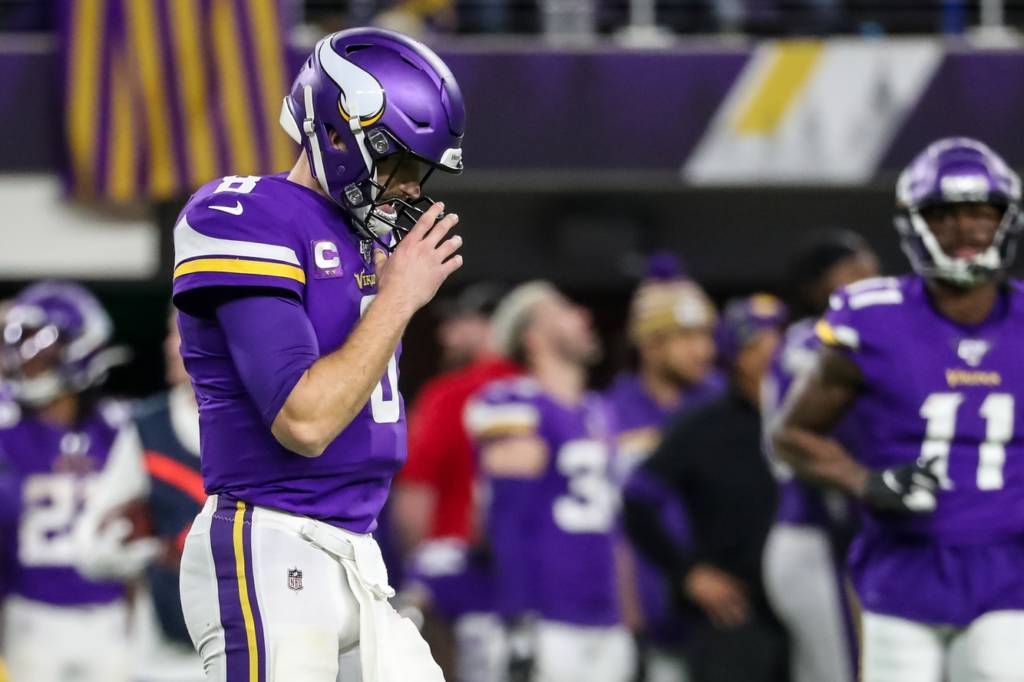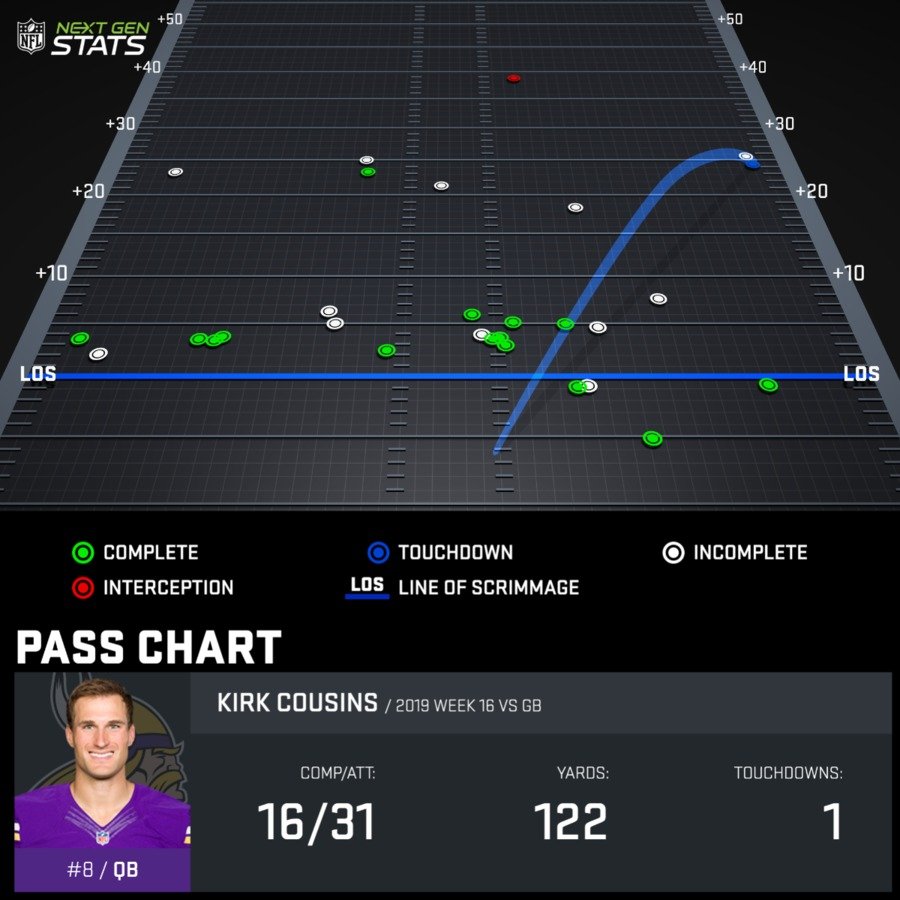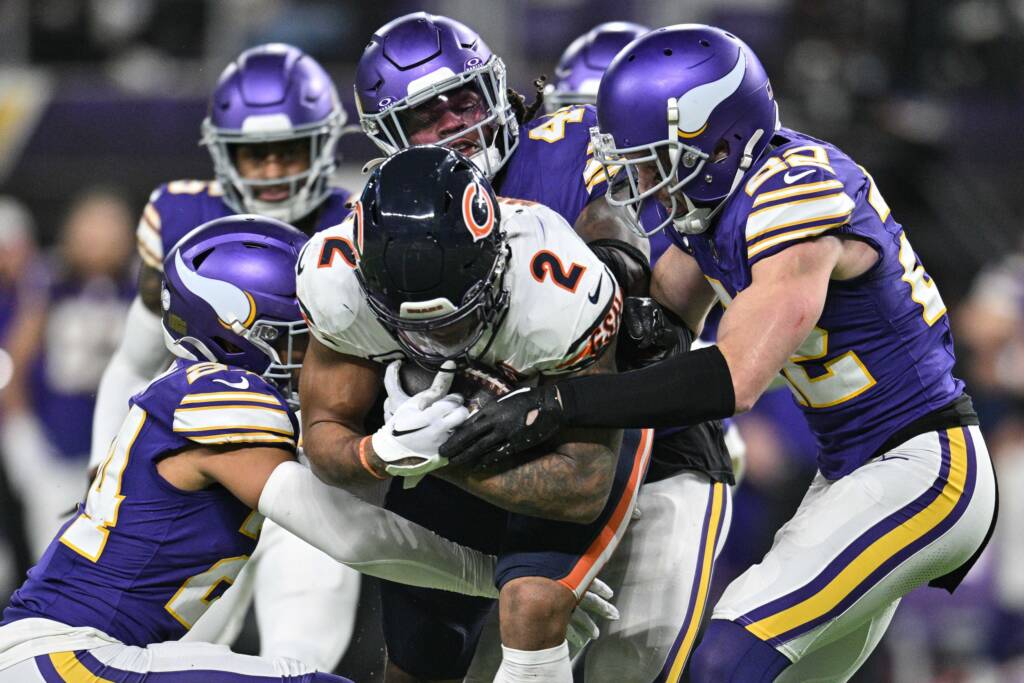Last week, we kicked off a two-part series examining how two offenses from the same coaching tree produced vastly different results when their teams faced off last season. On the one hand, quarterback Aaron Rodgers and head coach Matt LaFleur of the Packers more or less performed around or just under average on the season when facing the Vikings, which is what we looked at in pt. 1 of this series. On the other hand, Vikings quarterback Kirk Cousins, offensive coordinator Kevin Stefanski and offensive advisor Gary Kubiak posted their two worst games of the year by far against the Packers.
It is now time to dive into why Cousins and the Vikings offense crumbled against the Packers. Sure, the Green Bay defense was quite good last season, but the capitulation of the Minnesota offense in those two games made it appear as though the Pack were the best defense in the league.
To refresh from last week’s opening part of this series, let’s take a quick look at just how different Cousins’ production was in his two games versus Green Bay compared to his other 13 starts on the season.
Suffice to say, Cousins was horrific, at least in the box score, in these two games. He averaged -104 passing DYAR (defense-adjusted yards above replacement) in the two Packers games, while averaging nearly 80 DYAR in his other 13 games. If Cousins had maintained his 77.15 DYAR average from the 13 non-GB games over a 16-game sample, he would have landed at sixth in the league with 1,246 DYAR, just behind Lamar Jackson. Additionally, the Vikings only produced one other game with a negative DVOA passing offense in which Cousins started, which was Week 4’s game against the Chicago Bears.
What went wrong?
Going into the film study, I expected the same issues to crop up in both games. The Packers are not only familiar with the Vikings style of offense because of the Shanahan connection between the two coaching staffs, but Green Bay is also a recurring opponent because they play in the same division. Instead, the Vikings offense stalled out for almost entirely different reasons in each of the two matchups. There is some overlap with regards to allowing pressure (I mean, it’s the Vikings, so what’s new?), but aside from that, the two games presented different challenges Cousins needed to try to overcome.
So, let’s start with the Week 2 matchup. Despite how far down this game ended up in Cousins’ quality of performances last season, it was more of a volatile outing than a downright bad one. The thing is, volatility out of Cousins may feel worse considering how consistent he is in a general sense. In the first game, Cousins posted just under seven yards per attempt — which is neither good nor horrific — but coughed up multiple turnovers, including two mind-numbing interceptions. It was Cousins’ only game all year with multiple interceptions.
The foundation for Green Bay’s defensive success in this game was press coverage and creativity in how they sent five-plus pass-rushers. As Mike Pettine defenses have shown before, that style of aggressive defense is highly volatile, but if you have the press cornerbacks for it — and Green Bay does — it can be suffocating. When the Packers deployed these two tactics together, especially versus the Vikings’ under-center formations and/or on critical (third/fourth) downs, they found great success in throwing off Cousins’ timing and forcing him into questionable plays.
[videopress f138b2K3]In this clip, Adam Thielen (right) is running a 10-12 yard ‘glance’ route and Stefon Diggs (left) is running a post between the hashes. Green Bay’s outside cornerbacks are both walked up to the line in press coverage in an effort to disrupt the timing of the routes in relation to Cousins’ drop back — and that is exactly what happens.
On this passing concept, Cousins wants to be able to hit the top of his drop and immediately fire the ‘glance’ to Thielen. The Packers, 49ers and Rams all love this simple concept as well. However, since cornerback Jaire Alexander (23) effectively jammed Thielen and slowed down his route progression, Thielen was not coming out of his route break as Cousins turned back around, meaning he had to move on to Diggs. Unfortunately for him, Diggs was also slowed down and covered quite well, so Cousins was forced to bail and throw the ball away.
[videopress 7QRUceN1]Here, the Vikings sort of try to answer Green Bay’s press tendencies. By presenting an offset stack with Diggs (inside, front) and Thielen (outside, back), the Packers are only really allowed to press the front player in a stack or bunch set. Trying to do so with the other is just asking to get picked/rubbed in all the traffic and allow a receiver to break free out of the chaos. And yet, Minnesota’s effort in this instance was all for naught because the cornerback playing the point (Kevin King, 20) did an effective job of pressing and slowing down Diggs’ route over the middle. King surrendered zero breathing room for Diggs, which persuaded Cousins to look elsewhere rather than force a tight pass over the middle. By the time Cousins turned his attention to Thielen, who was also smothered in coverage, Green Bay’s six-man pressure (via a ‘green dog’ assignment from linebacker B.J. Goodson) got home for a strip sack.
[videopress GGM8ICsj]Once again, Cousins’ first option had zero chance on this play. King (bottom) punks the receiver off the line of scrimmage and never lets him get into his route comfortably. As Cousins is turning his head around off the play-action fake, King damn near has the receiver in a headlock (which is perfectly fine within the first five yards) and Cousins instantly has to look elsewhere. The rest of the Packers defense does their job, especially Preston Smith (91) in closing on Cousins’ rollout path, to force yet another throwaway.
In all three clips, the extra second Green Bay’s cornerbacks afforded their pass rushers was enough to derail the Vikings’ pass concepts and put pressure on Cousins. Only one of the plays resulted in a harshly negative outcome (as opposed to simple incompletions on the first and third plays), but it was an outcome they were able to repeat for a large portion of the game.
Even as the Vikings turned to more shotgun formations as the game went on in an effort to pass their way back into the game, the Packers did not shy away from pressing. Doing so against shotgun looks can be a touch riskier for the defense, seeing as the quarterback should have a better chance at seeing route disruptions unfold since he does not have to turn his back, but that did not dissuade Pettine. In fact, it only got him to open up the playbook on his rush packages.
[videopress m3wN1lYb]Before the snap, the Vikings have six blockers to the Packers’ potential six rushers. How many and which players Green Bay will actually send can be tough to decipher, especially when the defensive backs are just in press/press bail coverage across the board.
The Packers use this ambiguity to manipulate the Vikings’ pass pro rules and end up with two pass rushers versus two blockers to one side, while eating up four blockers with just two pass-rushers on the other. This happens because the center has someone in the gap to his right, so he must in part account for that player. In addition, Za’Darius Smith (55) is lined up over the left guard and seemingly rushing from that side, but immediately cuts across the formation to move the left guard inward while also helping occupy the center. In the meantime, outside linebacker Smith (91) dropped into coverage and aided in taking away the slant route from the slot. Green Bay’s two pass-rushers on the left side of the line get 1-on-1s while Cousins’ primary read is covered, earning the Packers (surprisingly) their only sack on the day.
Well-executed press coverage and some nifty pass-rushing concepts kept the Vikings down for the better part of four quarters. Near the end of the game, Cousins led a nice drive that put the Vikings inside the Green Bay 10-yard line with the chance to take the lead, nearly wiping away the Packers defense’s hard work to that point. Unfortunately, Cousins mustered the rare courage (recklessness) to force a pass into a tight window in the back of the end zone, which ended with King making a hell of an interception to all but close the game.
As I said earlier, Cousins was not all bad in this game despite the volatility, some of which was his fault and some of which was not. Cousins was on-form whenever the Packers were in more basic zone coverages and/or rushes four-or-fewer pass-rushers. Of course, the Packers knew better than to use those looks more often than was necessary to keep Cousins on his toes, but it’s still somewhat encouraging that Cousins took advantage when the Packers did take their foot off the gas. It just wasn’t enough.
Cousins’ second run-in against the Packers was not only a much worse showing overall, but also much less interesting in how he arrived at his poor performance. Whereas the first game showed an up-and-down Cousins somewhat keeping up with a Green Bay defense doing well to toy with him, the second game featured a shell-shocked, trigger-shy version of Cousins that can be traced back almost exclusively to how much pressure the Vikings allowed.
Minnesota’s run game was nonexistent (notably Dalvin Cook and Alexander Mattison were both out) and Cousins was forced into more shotgun formations early. The line did not handle either of those factors very well at all. Three, four, five, six rushers — it did not matter. Anything and everything was getting home versus the Vikings offensive line that day. Not that their offensive line was great in the first game, but they imploded in that second game.
With that said, one consistent factor between the first and second Packers game is how effectively Green Bay’s cornerbacks maintained press coverage. Alexander allowed one deep throw down the right sideline for a touchdown, but aside from that, the Packers’ cornerbacks shut down the Vikings’ receivers with their press coverage.
[videopress LIANjaMQ] [videopress eYkKAVYX]Even if the Packers’ cornerbacks were not always directly getting a hand on the ball, the disruption they caused right before or at the catch point was often enough to make plays difficult for the Vikings’ receivers to finish. Seldom in the second game did Minnesota’s receivers get clean looks off the line; seldom did they find separation later on in routes after being jammed at the line. Couple that with the relentless pressure Green Bay found (five sacks and seven QB hits) and it is not difficult to see how Cousins had a hard time in this one.
Moreover, Cousins’ struggles made for a particularly damning passing chart. Almost all of Cousins’ pass attempts were either short passes to try to gain something against Green Bay’s smothering, or desperate heaves down the field, which is a pattern Cousins often showed in Washington as well.
On 36 registered drop backs (including the sacks), Cousins threw a single pass between 10-20 yards. For any quarterback in any game, that would be quite stunning, but in an offense that loves to throw over the middle via play-action, it feels particularly damning. Granted, the Vikings’ receivers seldom got open to that area in this game and Cousins did not have much time to cycle through drop back passing concepts very often, but still.
Closing Thoughts
On some level, quality press coverage and consistent pressure will rattle any quarterback. Between the Vikings’ below-average offensive line and Cousins’ shakiness when thrown off-schedule, however, those issues were accentuated. That is especially true for a Vikings offense that lives and dies off of play-action. When that play-action timing is disrupted, those plays fall apart, then Minnesota gets behind in games, then they must turn to shotgun formations to better execute drop back passing concepts, and so goes the unraveling of the Vikings’ offensive foundation.
Seeing as the Packers’ defense is returning most of its starters, as well as LaFleur’s familiarity with the Vikings offense and Pettine as defensive coordinator, it is fair to assume that the issues that plagued Cousins’ outings against Green Bay in 2019 may again show up in 2020. If anything, the biggest change in this matchup is likely the loss of Diggs from the Vikings offense in favor of rookie Justin Jefferson. The swing in personnel over this offseason only favors the already-advantaged Packers defense.



